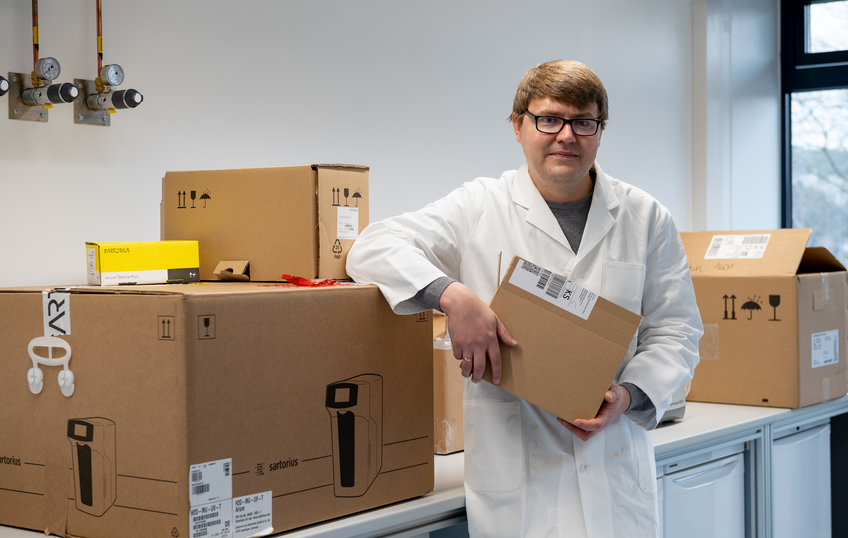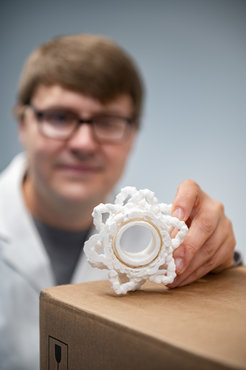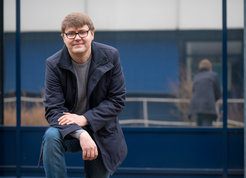
Oleksiy Kovtun
... explores our cellular parcel service
Since September 2021, the structural biologist heads a research group located at the City Campus. With his team, he investigates the structures and mechanisms of the cargo delivery within our cells.
Already as a youngster, Oleksiy Kovtun had a fable for understanding the mechanical functions of all kinds of objects. „One of my parents’ biggest concerns, when I was a kid, was probably me breaking our clocks,” the scientist laughs. “I was so curious to see how they work, that I would often attempt to disassemble them.” His interest in biological systems was sparked by his grandmother, who was a biology teacher. She presented him with a simple optical microscope and showed him magnified onion skins and other probes. It was these early experiences that awoke the researcher’s passion for sciences. Kovtun studied biology and biochemistry in his home country, Ukraine. At the University of Queensland in Brisbane (Australia), he conducted his PhD in Kirill Alexandrov’s Synthetic Biology group and later joined the team of structural biologist Brett Collins as a postdoc. He then worked in John Briggs group in Heidelberg, which later moved to Cambridge (Great Britain).
Research group from scratch
“When I learned that I will establish a research group at the MPI-NAT, I was very excited,” Kovtun says. According to the biologist, Göttingen is a rapidly developing center for cryo-electron microscopy (cryo-EM) not least due to the impressive achievements of local scientists like Holger Stark or Patrick Cramer. “While this method is costly and laborious, it gives us a unique way of solving important problems. An excellent example of that is Patrick Cramers team’s work on antivirals against SARS-CoV-2, giving us clues on how to create more efficient drugs to mitigate the ongoing pandemic.” In Göttingen, there is a growing community of scientists conducting interesting research with cryo-EM, which is why Kovtun is looking forward to collaborating and exchanging views with his new colleagues.
But first, the researcher has to set up his new lab at the City Campus, which he is pretty much building from scratch. “At the moment, I have just one other team member but we will expand soon,” Kovtun reveals. In his first months at the institute, the group leader’s workdays mainly comprised administrative tasks. Since some of the deliveries are currently delayed due to the pandemic, Kovtun had to postpone the start of his lab works. “I had to change my plans a bit, but gained more time to develop experimental pipelines and to think about how to arrange my lab most efficiently. Now, I feel very well prepared and cannot wait to start.”
Cellular ‘delivery trucks’

Considering his field of research, there is actually some irony in the scientist’s delayed deliveries. That is because Oleksiy Kovtun explores how cargo is delivered within our cells.
Living cells need to transport all kinds of things, like metabolites, hormones, enzymes, or drugs. Kovtun wants to understand the structure and mechanisms of the ‘delivery trucks’ that pick up cargo from main transport hubs within our cells, so-called endosomes. The trucks are molecular machines made of many proteins that fit, move, and work together. This compound design makes them versatile: The ‘trucks’ can switch between multiple cargo types and transport destinations by rearranging some of their parts.
“We already know the principal mechanism of how these molecular machines work. They recognize and concentrate the cargo that needs to be transferred. Then they form a coat made of proteins around the cargo-enriched membranes to pull them out of the endosome. At last, they send the cargo to its correct destination. This is called membrane trafficking,” explains Kovtun. “However, we are far from understanding how exactly these machines are assembled and regulated and how they tune their cargo and trafficking route specificity.”
Cryo-EM: the game changer
To shed light on these questions, Kovtun uses cryo-EM for which he describes the game-changing advantage: “In the past, we relied on crystallization as a way to turn tiny, elusive molecules into crystals – macro-objects that can be probed for their structural properties. However, crystallization is very tricky to use with larger biomolecules and becomes nearly impossible for membrane coats. Therefore, we were mainly limited to studies of individual parts or small subassemblies of delivery trucks. Now with cryo-EM, we can look at an entire molecular machine at once, by computing the overlay of thousands of magnified images of snap-frozen particles of the machine to produce its well-resolved three-dimensional blueprint.”
The biologist also sees an opportunity in exploring different approaches to help bring the desired objects under the microscope: “My previous research revealed how some of the trucks assemble on membranes in a test tube. Now I am working to find ways to capture their architecture on natural endosomes or directly in cells.”
The bigger plan
Even subtle alterations in membrane trafficking can have fatal consequences. For example, deviations in the structure of the delivery trucks can potentially affect the neuronal system causing neurodegenerative diseases such as Alzheimer’s. Disturbances of the transport system are not uncommon and can derive from mutations, malfunctions, viruses, or bacteria. “My bigger plan is to gather sufficient knowledge on the molecular trucks so that we can eventually modify their activities,” the scientists explains. “This knowledge will help designing pharmaceutical drugs and developing therapeutic strategies. I am really excited to see the first results.”
From science fiction to scientific story telling
Being asked about his hobbies, Kovtun says winkingly: “Like probably half of the colleagues here, I really like to go jogging or hiking to detox from workdays. I also have a weakness for good stories,” he reveals. He is particularly fond of science fiction works from classic authors like Isaac Asimov or Robert Sheckley. In science fiction novels and movies, the structural biologist is impressed by how the creators manage to elucidate complex scientific processes to the audience. “These works inspire me to look at my own research with different eyes. I always try to see how I would convey the meaning of my findings to society.”

Five questions to Oleksiy Kovtun
Which other job could you imagine pursuing?
Photographer or visual artist. I find it fascinating to tell stories through visuals. Not that it is much different from structural biology.
If you could live anywhere, where would it be?
Somewhere by the sea and near mountains.
How do you recharge your batteries after a tough day of work?
Exercise is the best cure to wear off a tough day. Cycling and jogging are amazingly effective to recuperate and reset the brain. A challenging hike is even better if time allows.
You are waiting for the discovery/invention of…?
A populism-resistant democracy. I know it is far-fetched and maybe utopic, but what if…?
Is there anything you wish would come back into fashion?
Night trains. A lot of them leading to all kind of destinations. Imagine spending a weekend in Rome without wasting productive time on traveling. You can also keep all these water bottles when boarding – unlike flying – and arrive at the destination well-rested.

